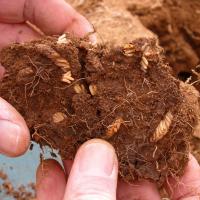Diagnosing locusts and grasshoppers in crops
Chewing pests that can cause complete defoliation if populations are high enough.
What to look for
- Adults up to 40mm long with black spot on tip of clear hindwing, X-shaped mark behind head and red shanks of hind legs.
Insect Adult
- Nymph locusts resemble adults but have dark shanks and lack wings.
Insect Larvae
- Leaves and stems have chewed pieces missing with complete defoliation of plants in extreme cases.
- Established green crops tend to be avoided by hoppers, although the edges of crops can be damaged. Crops that are beginning to dry off when locusts begin to fly are susceptible to damage; locusts cause little if any damage to crops that have dried off.
Plant
Where did it come from?

Green bridge
- Plague locusts are native insects that have two generations - in spring and autumn; and require green feed.
- Nymphs have five growth stages (instars).
- Oversummering eggs are laid in spring for the autumn generation, often in heavy soils.
- Green bridge feed is required for the autumn generation to lay sufficient eggs to pose a risk for crops in spring.
- Adults form swarms that can fly long distances and cause significant damage.
Management strategies

Cultivation

Spraying insecticide
- Egg beds can be destroyed with cultivation, otherwise monitor eggs beds and treat with insecticides with bare-ground residual once eggs start to hatch.
- Applying insecticide over entire paddocks is necessary to prevent extensive damage from locusts.
- To achieve effective control, the best time to apply an insecticide is when locusts are hoppers. Treating small areas of dense masses of hoppers immediately after hatching can also be worthwhile, but will only control a relatively small proportion of the total numbers within a paddock and may involve several sprays as hatching times are staggered.
- If locust swarms do form, they should be controlled when they first fly into an area where their feeding will cause damage. It is important to be aware of the likelihood of locusts flying onto your property and to stay vigilant.
- Sprays must be applied directly onto the locusts and the vegetation on which they are feeding.
- Barrier spraying to keep locusts out of an area is not effective.
Economic and financial considerations
To assist in assessing the economic risk and financial costs associated with various treatment strategies go to MyEconomicTool
There may be other economic and financial implications that need to be considered when choosing a management option. These may include:
Pre-crop- Understand the potential risk of a locust and grasshopper plague and potential yield losses associated with feeding damage.
- Assess the costs and benefits of taking preventative action.
- Assess the cost and benefits of controlling against the development of a ‘green bridge’ (self sown cereals and grass weeds) in order to reduce exposure to attack.
- Compare the costs, benefits and risk of each management option against the alternative option of doing nothing.
- Consider risks, costs or savings associated with a no treatment option or delaying treatment option.
- Consider the potential risk of re-infection and costs of further treatment.
- Ignore all previous treatment costs in assessing current management options.
- There are no post crop economic considerations.
View these economic considerations in more detail.
How can it be monitored?
- If there was locust activity in autumn, check for eggbed hatching in spring and monitor hopper numbers.
Page last updated: Monday, 1 May 2017 - 12:23pm




